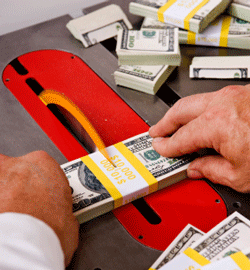Contributed by Gary Harpster, Avionics Installation Sales Representative

Tight aircraft maintenance budgets have been slashed to dangerous levels.
When our economy changed a few years ago, an unusual trend began to emerge in the business aviation industry. Aircraft maintenance budgets, by and large, were regarded as discretionary expenditures and were reduced to dangerously low levels. I suspect that many of these shoestring maintenance budgets were incapable of supporting the necessary maintenance and repairs for an aircraft to remain airworthy.
Without passing judgment on anyone, I think more than one Director of Maintenance (DOM) was caught squarely between airworthiness requirements and budgetary constraints. DOMs did what they could to keep aircraft operational with the resources they were given. In some cases, I believe maintenance items that would normally have been repaired were instead nursed along with a patchwork of temporary fixes and creative ingenuity.
This practice of shoestring maintenance holds several pitfalls, which are now beginning to become apparent for some operators:
- Important maintenance issues have gone unresolved.
- Unresolved issues have caused collateral damages.
- Collateral damages have led to additional, preventable repair costs.
- Incomplete maintenance and damages have compromised aircraft resale values.
Consider, for example, an aircraft that has a maintenance budget that is much lower than the average cost of compliance. The aircraft may remain airworthy. However, when the next inspection comes due, the out-the-door costs may be much higher than average to correct previously unresolved issues. Let’s take this example to the next level.
If maintenance is deferred during A and B inspections to lower inspection costs, it will often cost more to correct those issues during C and D inspections. If maintenance is also deferred during the D or 12 year inspection, this will negatively affect the resale value of the aircraft. The same principle applies to avionics upgrades.
How do we go about breaking the pattern of shoestring maintenance? First, the aircraft owner needs to acknowledge that the pattern exists. Next, the owner needs to understand why the cycle began and what the contributing factors are so it can be prevented in the future.
The past few years have established an inaccurate baseline for maintenance expenditures. I strongly encourage aircraft owners to take a hard look at their maintenance budgets with their DOMs, and ask the tough questions. Historical data for required maintenance is available on request, and provides a reasonably accurate baseline for budgeting purposes.
Duncan Aviation provides complete maintenance, repair and overhaul (MRO), modification, upgrade and support services for business aircraft. For assistance creating a maintenance budget that provisions for passenger safety and aircraft value, please contact me. I will be happy to provide our historical maintenance comparison costs.
Gary Harpster serves as an Avionics Installations Sales Rep. at Duncan Aviation's Lincoln, NE (LNK) full-service facility, specializing in Hawkers and Learjets. He began working in aviation in 1977.


